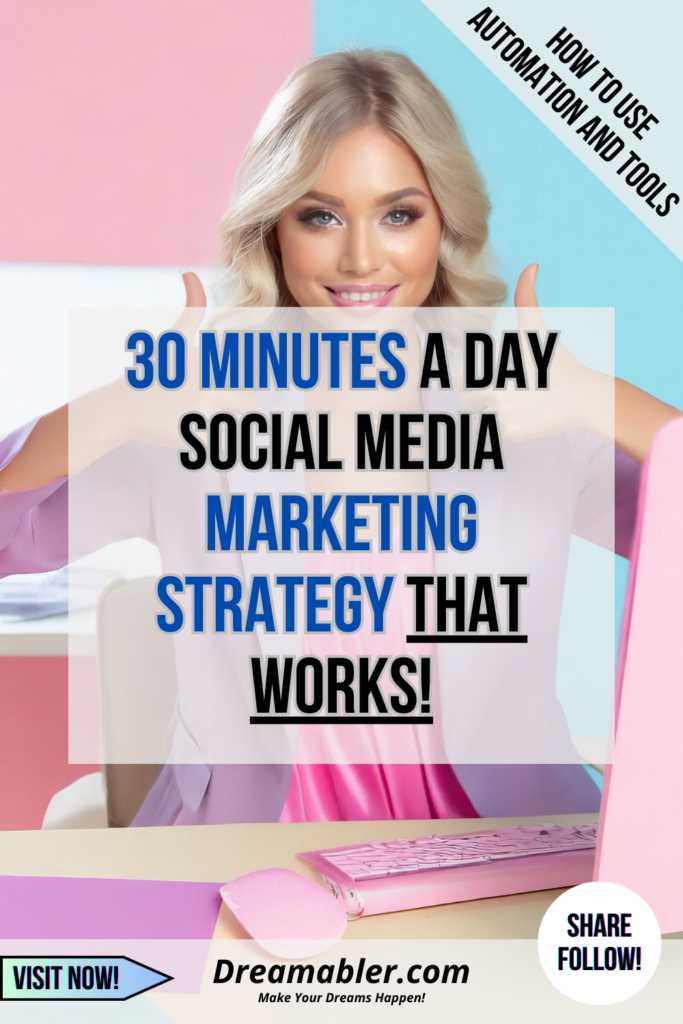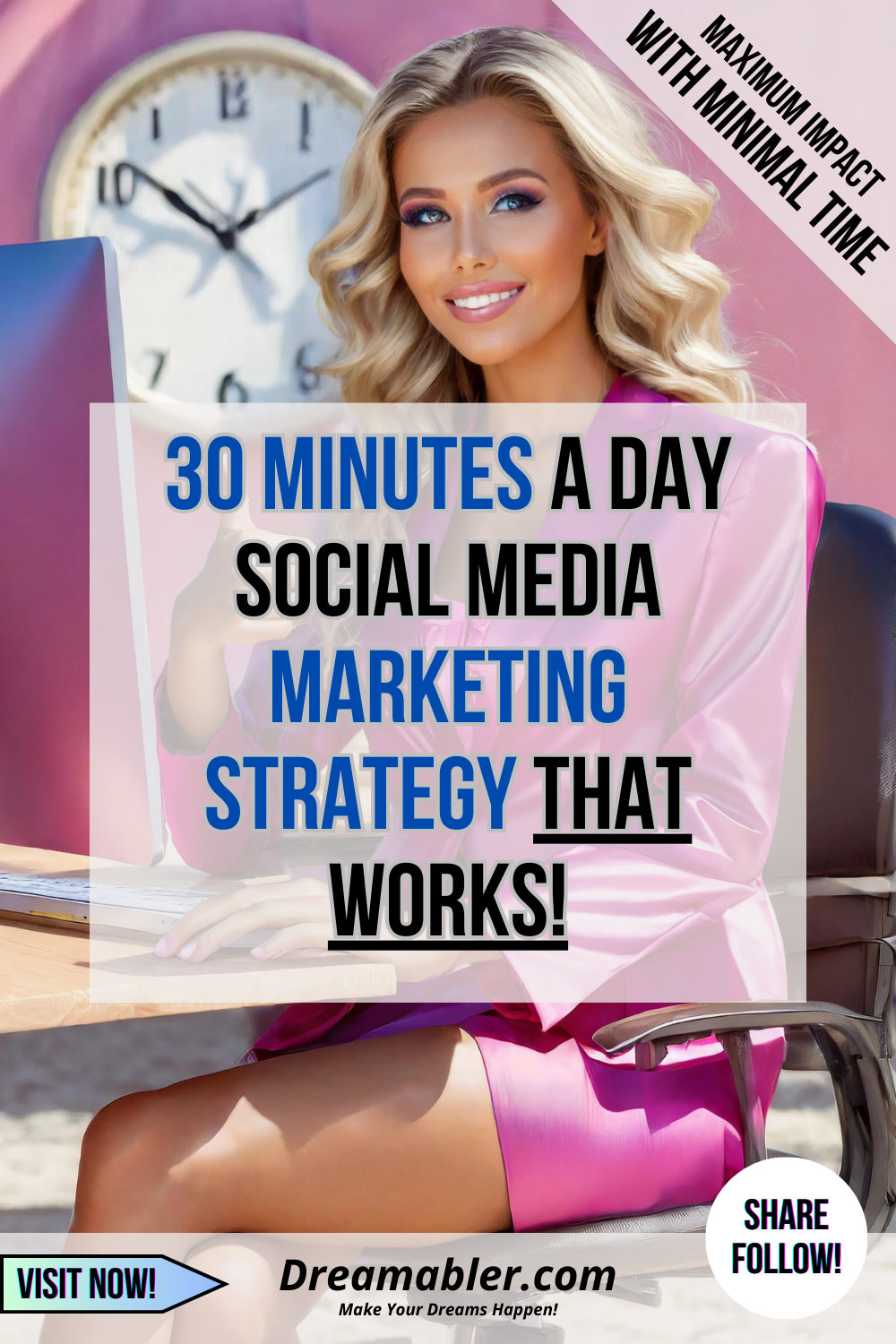Last Updated on January 26, 2024 by Mika
The average daily social media usage of internet users worldwide amounted to 151 minutes per day, according to a report by Statista.
As of 2024, the total number of social media users worldwide is approximately 4.95 billion. This figure represents about 61% of the world’s population. Facebook leads the social media platforms with 3.05 billion users. This information was reported by Demand Sage.
Harnessing the power of these platforms for marketing is not just a strategy; it’s a necessity. With billions of users across various platforms, social media stands as a formidable force in the marketing world, offering unparalleled opportunities for creators and entrepreneurs, including bloggers to share their work and grow their businesses.
The Time Challenge in Social Media Marketing
The potential of social media to expand the audience and enhance brand visibility is well-known. However, the reality is that social media marketing demands significant time and effort.
From researching audience trends to creating engaging content and interacting with followers, these tasks are time-intensive. For entrepreneurs and content creators, whose schedules are already packed, finding additional time for social media can be daunting. It’s fair to say that for most of us, it’s hard.
The Consistency Dilemma
A critical aspect of social media success is consistency in content posting. Platforms favor regular engagement, and failure to maintain this can lead to reduced visibility and slower growth.
This requirement often puts creators in a tough spot, as they feel compelled to constantly feed the algorithm while also striving to establish genuine connections with their audience.
Content Batching: Not A Perfect Solution
Many bloggers turn to content batching – the process of creating and scheduling content in bulk – as a solution to this time crunch. While it can be a useful tool, it’s not without its drawbacks.
Some bloggers find that batching makes it harder to stay present and engaged with their audience, diminishes the enjoyment of content creation, and can even impact the quality of the content itself. That is what happens when you “mass produce” creative things.
Maximizing Impact with Minimal Time
Effective social media marketing doesn’t require hours of your day. By focusing on a 30-minute strategy that involves targeted research, efficient content creation and use of effective tools, strategic publishing, and meaningful engagement, you can maximize your impact on social media without daily pressure.
This approach not only helps in growing your brand but also ensures that you have time for other critical aspects of your business and personal life. It’s often the quality of interactions, not the quantity of time spent, that drives real success.
The 30-Minute Solution
The situation is not as bad as it may first sound. Luckily, several strategies and tools exist that will help with the daunting task of social media marketing.
Let’s take a look at a streamlined approach to social media marketing that requires just 30 minutes a day. It’s about maximizing efficiency and focusing on impactful actions that grow your reach and audience without monopolizing your time.
Strategic Time Allocation
The essence of this strategy lies in smart time management. By dedicating less time to social media, you free up more hours for other creative endeavors. This, in turn, generates more content that can be repurposed across your social channels.
Focusing on One Platform
Begin by concentrating on the platform that aligns best with your audience and business objectives. Once you’ve established a consistent pattern of conversions here, you can think about expanding your reach to other platforms, using the same content in different formats to save time.
The Essentialist Approach
Drawing from Greg McKowen’s philosophy in Essentialism, this 30-minute-a-day strategy emphasizes doing fewer things but doing them exceptionally well.
The first step is to identify the type of content that resonates most on your chosen platform and focus your efforts there for maximum impact.
Goal-Oriented Social Media
The next step is to reframe your social media objectives to focus on engagement and conversion rather than follower count. You don’t need followers if they are just dull numbers, you need followers that engage with you.
Set specific, achievable goals such as increasing email subscribers (you can reach all of them directly simply by sending email, sidestepping gatekeepers such as Instagram or Facebook), boosting sales (or affiliate income, etc., that should be any way one of your goals if you are here to make money online!), or growing your community. I’m speaking about followers who engage with you actively.
The Daily Social Media Routine
Break down your 30-minute social media routine into four key activities:
- Research
- Content Creation
- Publishing
- Outreach & Engagement
Allocate a specific amount of time to each task to ensure a balanced approach. But DO NOT EXCEED daily for 30 minutes. You have to split that half an hour between these tasks to make the strategy work at its full potential. In the end, it makes you also more efficient!
Tailoring Strategies for Different Platforms
Each social media platform has its unique strengths and requires a specific approach, especially when operating within a 30-minute time frame.
For instance, Instagram’s visual-centric platform is ideal for storytelling through images and short videos like Reels.
Twitter, on the other hand, excels in conversation and quick updates, making it perfect for engaging in real-time discussions and sharing brief insights.
Efficient Research and Content Creation
- Research (5 minutes): This phase involves identifying trending topics, and relevant hashtags, and understanding what competitors are doing. Tools like Google Alerts or social media analytics can provide quick insights.
- Content Creation (15 minutes): Focus on creating content that can be quickly produced yet has a high impact. This could include simple graphics, short video clips, or quick updates. Utilizing templates or batch-creating similar content types can save time. Here tools like Tailwind and Canva can be also extremely helpful!
Streamlined Publishing and Engagement
- Publishing (2 minutes): Use scheduling tools to post your content. Ensure that everything, from captions to hashtags, is prepared in advance. Again tools like Tailwind and Canva can be also extremely helpful!
- Outreach & Engagement (8 minutes): Spend this time interacting with your audience. Respond to comments, engage with followers’ content, and explore potential collaborations or shoutouts.
- Generate content with AI
- Schedule & autopost
- Instagram Marketing
- Pinterest Marketing
Tailwind’s unique “done for you” marketing revolutionizes results.
Example Strategies Maximizing 30 Minutes a Day

Instagram Strategy
- Research (5 minutes): Quickly scan through trending hashtags, competitors’ profiles, and Instagram Explore page. Save any interesting post ideas or trending audio for Reels.
- Content Creation (15 minutes): Create a visually appealing post or a short Reel. Use tools like Canva for quick graphic designs or edit a pre-recorded video. Prepare a compelling caption with relevant hashtags (3-5 is optimal).
- Publishing (2 minutes): Schedule or post your content. Ensure all details like tags, location, and alt text are in place.
- Engagement (8 minutes): Respond to comments on your posts. Visit the profiles of your followers and engage with their content. Leave meaningful comments on posts in your niche.
Pinterest Strategy
- Research (5 minutes): Explore trending pins and boards in your niche. Note down popular themes and keywords.
- Content Creation (15 minutes): Design a pin using a template or create a new one. Ensure it has an attractive image, a clear headline, and a call to action. Optimize the pin description with keywords.
- Publishing (2 minutes): Post your pin to relevant boards, including group boards for wider reach.
- Engagement (8 minutes): Engage with followers by commenting on their pins. Search for pins in your niche and leave thoughtful comments. Follow relevant boards and pinners.
Twitter Strategy
- Research (5 minutes): Look for trending topics, hashtags, and conversations relevant to your niche. Note any potential influencers or key figures to engage with.
- Content Creation (15 minutes): Draft a tweet or a short thread that provides value, insight, or engagement to your followers. This could be a tip, a question, or a comment on a trending topic. Use a tool like TweetDeck to manage and schedule tweets.
- Publishing (2 minutes): Post or schedule your tweet. Make sure to include relevant hashtags for increased visibility.
- Engagement (8 minutes): Respond to mentions and comments. Retweet and comment on tweets from others in your industry. Spend time building relationships by engaging in conversations.
Facebook Strategy
- Research (5 minutes): Quickly scan your Facebook feed, groups, and pages of competitors or similar interests. Note trending topics and content styles that are engaging audiences.
- Content Creation (15 minutes): Develop a post that resonates with your audience – this could be a status update, a photo, a link to your blog, or a short video. Use tools like Canva for quick image editing or to create simple graphics.
- Publishing (2 minutes): Schedule or post your content. Ensure all details like tags and location are accurate. If sharing a link, check that the preview appears correctly.
- Engagement (8 minutes): Respond to comments and messages on your page. Spend time engaging with other pages and groups by commenting and sharing relevant content.
YouTube Strategy
Due to the nature of content creation on YouTube, the strategy will be slightly different, focusing on weekly rather than daily tasks.
- Research and Planning (Weekly, 30 minutes): Dedicate time once a week to research trends, keywords, and competitors. Plan your video content based on this research.
- Content Creation (Weekly, varies): Depending on your capacity, set aside a day or two for filming and editing. This can be broken down into smaller segments throughout the week.
- Publishing (Weekly, 15 minutes): Once your video is ready, spend time optimizing the title, description, and tags. Schedule or upload your video.
- Engagement (Daily, 5 minutes): Allocate a few minutes each day to respond to comments, engage with other channels, and analyze viewer feedback.
TikTok Strategy
- Research (5 minutes): Look for trending challenges, sounds, and hashtags. Observe what content is performing well in your niche.
- Content Creation (15 minutes): Create a TikTok video using trending sounds or participating in a challenge relevant to your niche. Keep it authentic and fun.
- Publishing (2 minutes): Post your video with a catchy caption and relevant hashtags for maximum reach.
- Engagement (8 minutes): Engage with your audience by responding to comments. Also, spend time interacting with other users’ content, especially those in your niche or related fields.
These strategies for Instagram, Pinterest, and Twitter are designed to maximize your social media impact in just 30 minutes a day.
By focusing on efficient research, targeted content creation, strategic publishing, and active engagement, you can effectively grow your presence on these platforms without overwhelming your schedule. Consistency and relevance are key to success in social media marketing, and you won’t be present on all platforms, start just with the one, with the most important for your niche.
Expanding on the 30-Minute Social Media Solution

Leveraging Automation and Tools
To make the most of a 30-minute social media strategy, leveraging automation tools is key.
Tools like Tailwind, Hootsuite, Buffer, or Later can be used to schedule posts across different platforms. This not only saves time but also allows for posting during peak engagement times without being online.
Furthermore, using analytics tools can provide quick insights into what content performs best, helping to refine your strategy without extensive manual research.
Quality Over Quantity
The 30-minute solution emphasizes the importance of quality content over quantity. It’s about creating impactful, engaging posts that resonate with your audience rather than flooding your channels with content.
This approach aligns with the algorithms of most social media platforms, which favor engagement (likes, comments, shares) over the sheer volume of posts.
Strategic Content Planning
A significant part of this strategy involves planning content. This could mean setting aside a specific day to brainstorm and outline content for the week or month.
By having a clear content calendar, you can efficiently produce and schedule posts, ensuring a consistent online presence without daily pressure.
Engagement in Short Bursts
Engagement doesn’t always require long hours. In this 30-minute strategy, engagement is about short, focused bursts of activity.
This could involve quickly responding to comments, engaging with followers’ content, or participating in relevant online conversations.
These small interactions, when consistent, can significantly boost your social media presence and foster a loyal community.
Adapting to Platform-Specific Needs
Understanding the unique demands of each platform is crucial. For instance, Instagram might require high-quality visuals and stories, while Twitter might be more about engaging in the latest trends and conversations.
Tailoring your content and engagement to each platform’s strengths within the 30-minute window can lead to more effective results.
Measuring Success and Adjusting
It’s important to regularly measure the success of your social media efforts.
This doesn’t have to be a time-consuming process. Many social media platforms offer built-in analytics tools that provide quick insights into post-performance, follower growth, and engagement rates. Use this data to adjust your strategy, focusing more on what works and less on what doesn’t.
Creating a Sustainable Social Media Plan
The ultimate goal is to develop a social media strategy that is sustainable and aligns with your goals.
It’s about knowing your limits and setting realistic expectations. Consistency is key, but so is flexibility. Be prepared to adapt your strategy as your business and social media landscape evolve.
Self-Care and Discipline in Social Media
While discipline is crucial in maintaining a consistent social media presence, self-care should not be overlooked.
Avoid burnout by ensuring that your social media activities do not encroach on personal time or well-being. Set clear boundaries and stick to your 30-minute limit.
Impact of the 30-Minute Social Media Strategy

Embracing the 30-minute social media strategy has been a game-changer, particularly in how it has revolutionized time management and productivity.
By implementing this focused approach, I’ve successfully reclaimed hours that were previously lost in the endless scroll of social media management.
This newfound time has been redirected towards enriching activities, most notably in creating content for Dreamabler.com. The ability to produce more thoughtful, in-depth content without the constant distraction of social media upkeep has not only enhanced the quality of the blog but also brought a renewed sense of fulfillment and purpose to my work.
The beauty of this strategy lies in its simplicity and effectiveness. By concentrating efforts into a concise, 30-minute window, social media marketing becomes less of a daunting task and more of a streamlined, productive activity.
This approach aligns perfectly with the ethos of maintaining a healthy work-life balance. It underscores the importance of having a real life outside the digital realm, a life filled with creative pursuits, personal growth, and meaningful interactions.
Moreover, this strategy serves as a reminder that while social media is a powerful tool for connection and business growth, it should not overshadow other aspects of life.
In a world increasingly dominated by digital interactions, it’s crucial to remember that real life happens away from the screen. Until humanity fully transitions into a virtual reality-dominated existence, the physical world with its tangible experiences and personal connections remains irreplaceable.
The 30-minute social media strategy is not just about saving time; it’s about redefining priorities and reclaiming the narrative of our daily lives.
It’s a testament to the fact that with the right approach, it’s possible to harness the power of social media effectively without letting it consume our entire day.
This strategy has been instrumental in allowing me to focus on what truly matters, both professionally and personally, and I believe it can do the same for you!
Share Your Experience
Have you tried the 30-minute social media strategy? I’d love to hear about your experiences! Whether it’s made a significant difference in your daily routine, helped you focus on other important tasks, or even if you’ve faced challenges implementing it, your insights are invaluable. Sharing your journey can inspire and guide others who are navigating the same path.
If you haven’t yet given this strategy a try, I encourage you to do so. It’s a practical approach to managing your social media presence efficiently, allowing you more time to engage in activities that enrich your life and work, like content creation or personal hobbies.
Also, don’t miss out on the latest tips, insights, and updates – subscribe to my newsletter. And of course, follow my channels on social media for regular updates, insights, and more.
Your feedback and participation are what make this community thrive. So, share your thoughts, subscribe, follow, and let’s keep the conversation going!







